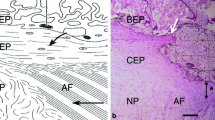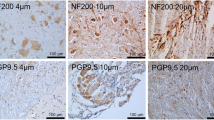Summary
Twenty disc herniations (DH) were studied immunocytochemically for macrophages and blood vessels. Serial thin frozen sections were immunostained with an antibody specific for tissue macrophages (monoclonal antibody to CD68 antigen) and the endothelium of blood vessels (polyclonal antibody to von Willebrand factor). With this method, blood vessels, often abundant, were observed in as many as 16/20 (80%) of the DH studied, 12 disc extrusions and 8 sequestrated discs, whereas abundant macrophages were noted in 11/20 (55%) of the DH. Macrophages were present only in areas with blood vessels and had presumably infiltrated the tissue from them. As has been noted previously, some blood vessels are apparently newly formed as a result of tissue injury, whereas others were present in the disc prior to herniation. This is suggested by the lack of a clear correlation between the presence or absence of blood vessels and the preoperative duration of radicular pain. In areas of the DH where cartilage fragments occurred, both macrophages and blood vessels were particularly abundant.
Similar content being viewed by others
References
Ashton IK, Roberts S, Jaffray DC, Polak J (1992) Immunochemical demonstration of innervation and neurotransmitters in the human intervertebral disc. Presented at the Annual Meeting of the International Society for the Study of the Lumbar Spine, Chicago, Illinois
Bogduk N, Tynan W, Wilson AS (1981) The innervation of the human lumbar intervertebral discs. J Anat 132:39–56
Bogduk N, Windsor M, Inglis A (1989) The innervation of the cervical intervertebral discs. Spine 13:2–8
Coppes MIL, Marani E, Thomeer RT, Oudega M, Groen GJ (1990) Innervation of annulus fibrosus in low back pain (Letter). Lancet 336:189–190
Cordell JL, Falini B, Ether WN et al (1984) Immunoenzymatic labeling of monoclonal antibodies using immune complexes of alkaline phosphatase and monoclonal anti-alkaline phosphatase (APAAP complexes). J Histochem Cytochem 32:219–229
Grönblad M, Weinstein JN, Santavirta S (1991) Immunohistochemical observations on spinal tissue innervation: a review of hypothetical mechanisms of back pain. Acta Orthop Scand 62:614–622
Grönblad M, Virri J, Tolonen J et al (1994) A controlled immunohistochemical study of proinflammatory cells in disc herniation tissue. Spine (in press)
Guyton AC (1969) The blood cells. In: Function of the human body, 3rd edn. WB Saunders, Philadelphia, pp 85–98
Hardy MA (1989) The biology of scar formation. Phys Ther 69:1014–1024
Hirsch C, Schajowicz F (1953) Studies on structural changes in the lumbar annulus fibrosus. Acta Orthop Scand 22:184–231
Hirsch C, Ingelmark BE, Miller M (1963) The anatomical basis for low back pain. Acta Orthop Scand 33:1–17
Hsu S-M, Raine L, Fanger H (1981) Use of avidin-biotin-peroxidase complex (ABC) in immunoperoxidase techniques: a comparison between ABC and unlabeled antibody (PAP) procedures. J Histochem Cytochem 29:577–580
Jackson HC, Winkelmann RK, Bickel WH (1966) Nerve endings in the human lumbar spinal column and related structures. J Bone Joint Surg [Am] 48:1272–1281
Kelly PMA, Bliss E, Morton JA, Burns J, McGee JOD (1988) A monoclonal antibody (EBM 11) with high cellular specificity for human macrophages. J Clin Pathol 41:510–515
Kääpä E, Grönblad M, Holm S, Liesi P, Murtomäki S, Vanharanta H (1994) Neural elements in the normal and experimentally injured porcine intervertebral disc. Eur Spine J 3:137–142
Lindahl O (1962) Pain: a chemical explanation. Acta Rheum Scand 8:161–169
Mason DY (1985) Immunocytochemical labeling of monoclonal antibodies by the APAAP immunoalkaline phosphatase technique. In: Bullock GR, Petrusz P (eds) Techniques in immunocytochemistry. Academic Press, New York, pp 25–42
Maves TJ, Pechman PS, Gebhart GF, Meller ST (1993) Possible chemical contribution from chronic gut sutures produces disorders of pain sensation like those seen in man. Pain 54:57–69
Payan DG (1989) Neuropeptides and inflammation: the role of substance P. Annu Rev Med 40:341–352
Petersen M, LaMotte RH (1993) Effect of protons on the inward current evoked by capsaicin in isolated dorsal root ganglion cells. Pain 54:37–42
Reeh PW, Steen KH, Hanisch AE (1991) A dominant role of acid pH in inflammatory excitation of nociceptors in rat skin. Soc Neurosci Abstr 17:214–215
Sehested M, Hou-Jensen K (1981) Factor VIII-related antigen as an endothelial cell marker in benign and malignant diseases. Virchows Arch [A] 391:217–225
Steen KH, Reeh PW, Anton F, Handwerker HO (1992) Protons selectively induce lasting excitation and sensitization to mechanical stimulation of nociceptors in rat skin in vitro. J Neurosci 12:86–95
Tolonen J, Grönblad M, Virri J, Seitsalo S, Rytömaa T, Karaharju E (1993) Fibroblast growth factor in disc herniation tissue. An immunohistochemical study. Presented at the Annual Meeting of the International Society for the Study of the Lumbar Spine, Marseilles, France
Weinstein J, Claverie W, Gibson S (1988) The pain of discography. Spine 13:1341–1348
Yasuma T, Makino E, Saito S, Inui M (1986) Clinicopathological study on lumbar intervertebral disc herniation. 3. Comparison between surgical materials and clinical data. Orthop Trauma 29:1817–1826
Yasuma T, Arai K, Yamauchi Y (1993) The histology of lumbar intervertebral disc herniation. Spine 18:1761–1765
Yoshizawa H, O'Brian JP, Thomas-Smith W, Trumper M (1980) The neuropathology of intervertebral discs removed for low back pain. J Pathol 132:95–104
Author information
Authors and Affiliations
Additional information
Supported in part by grants from the Yrjb Jahnsson Foundation and the Memorial Foundation of Dorothea Olivia, Jarl Walter and Karl Walter Perklen, Helsinki, Finland
Visiting Research Student, University of Tartu, Estonia
Rights and permissions
About this article
Cite this article
Virri, J., Sikk, S., Grönblad, M. et al. Concomitant immunocytochemical study of macrophage cells and blood vessels in disc herniation tissue. Eur Spine J 3, 336–341 (1994). https://doi.org/10.1007/BF02200147
Issue Date:
DOI: https://doi.org/10.1007/BF02200147




